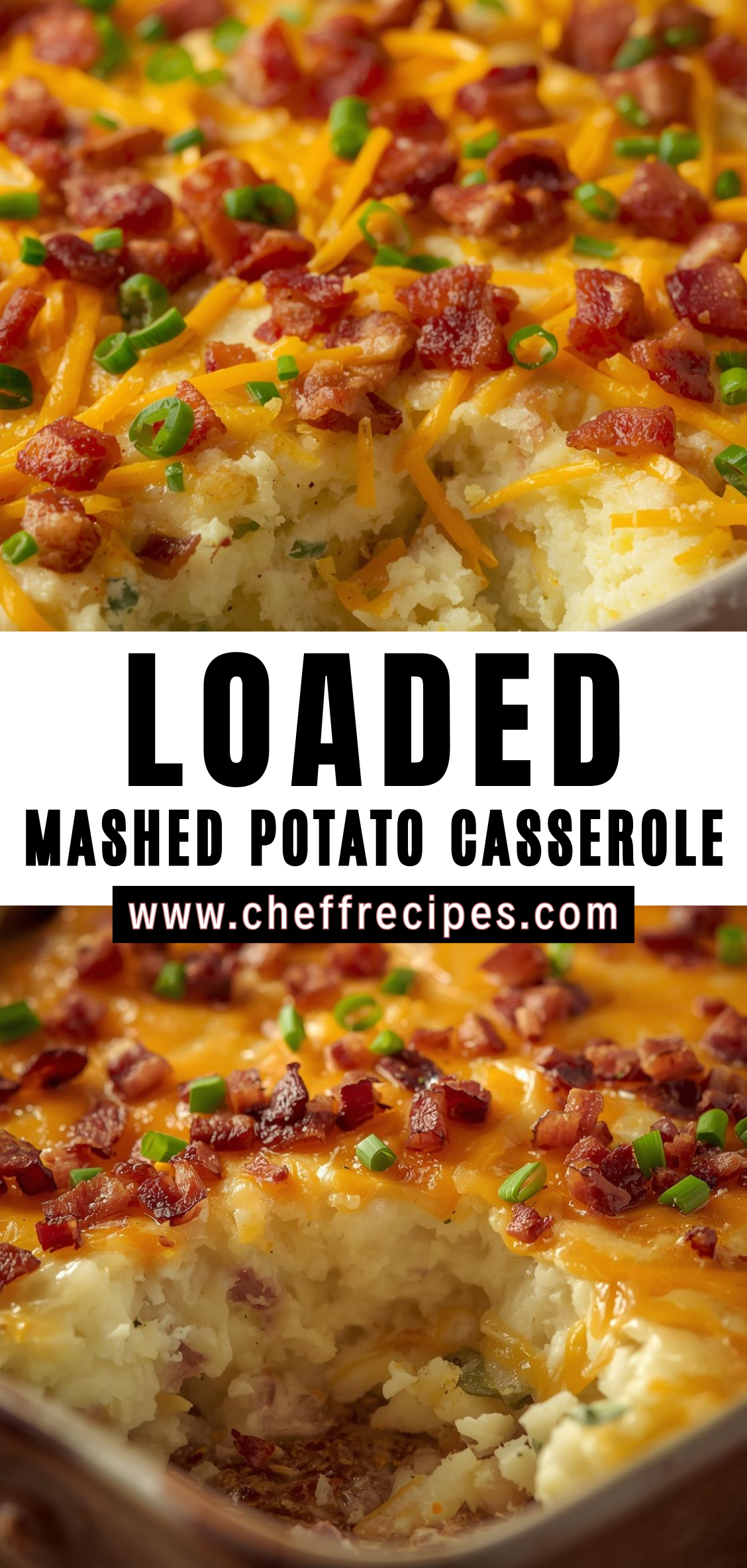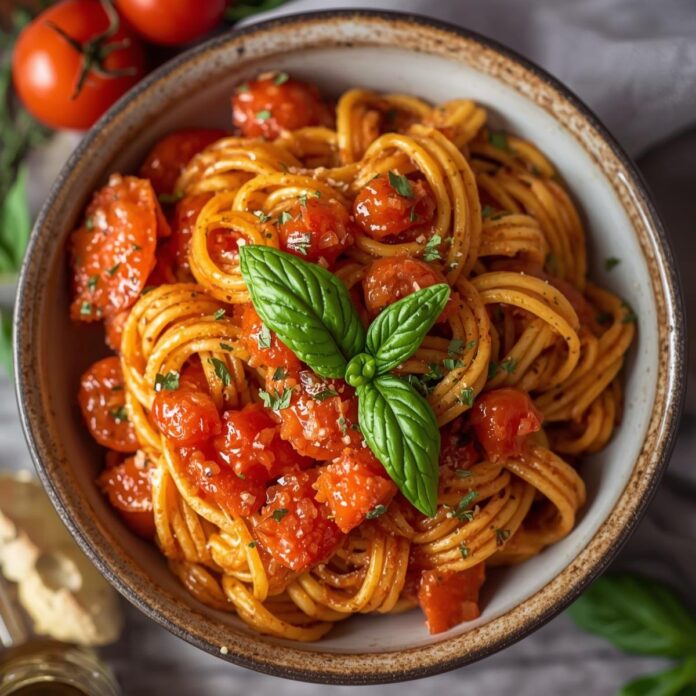Loaded Mashed Potato Casserole is the kind of comfort food that feels timeless, deeply familiar, and universally appreciated. It combines everything people love about classic mashed potatoes—creamy texture, buttery richness, and satisfying warmth—with the indulgent additions that define “loaded” dishes: melted cheese, crisp bacon, fresh scallions, and the cool tang of sour cream. The result is a hearty, crowd-pleasing casserole that can function as a star side dish or even as a centerpiece for casual gatherings. Whether served at a holiday table, a weekend potluck, or a simple family dinner, this dish has a way of anchoring a meal with its comforting presence.

What makes this casserole particularly appealing is its ability to elevate an ordinary bowl of mashed potatoes into something far more dynamic. Traditional mashed potatoes offer smoothness and warmth; the loaded version builds layers of texture and depth by incorporating salty, crunchy, creamy, and savory components. Each bite delivers a contrast—melty cheese against fluffy potatoes, crisp bacon against soft layers, sharp scallions cutting through richness, and pockets of sour cream giving intermittent brightness. The interplay between these elements keeps the dish satisfying without becoming monotonous even in larger portions.
Despite its indulgent nature, Loaded Mashed Potato Casserole is surprisingly versatile. It adapts well to different flavor preferences and dietary needs. You can make it extra creamy and luxurious for festive meals, or you can scale back the dairy for a lighter profile without losing the essential comforting character. You can incorporate roasted garlic for depth, smoked paprika for warmth, or multiple cheeses for a more complex flavor. It also pairs effortlessly with a wide range of proteins—from roasted chicken and glazed ham to grilled steak or sautéed vegetables—making it a reliable component of well-rounded meal planning.
Another reason this dish has earned a permanent place in modern kitchens is its make-ahead convenience. The casserole can be assembled in advance, refrigerated, and baked just before serving. This is invaluable for holidays or special events where timing becomes crucial and stovetop space is often limited. Unlike traditional mashed potatoes, which can lose their texture if held too long or reheated improperly, this casserole is designed to maintain its integrity. The baking process revitalizes the potatoes and re-melts the cheese, restoring the dish’s signature richness and warmth.
Beyond its practical strengths, Loaded Mashed Potato Casserole also carries a sense of nostalgic comfort. For many people, mashed potatoes are tied to memories of family gatherings or seasonal celebrations, and the loaded version takes that nostalgia and enhances it. The aromas that fill the kitchen as the casserole bakes—browned cheese, savory potatoes, smoky bacon—evoke anticipation and create a welcoming atmosphere. It is the type of dish that invites people to linger at the table, reaching for an extra helping even when they initially believed they were satisfied.
This introduction lays the groundwork for a deeper exploration of the dish. In the sections that follow, we will break down the ingredients in detail, discuss methods for achieving ideal potato texture, explore techniques for layering flavors within the casserole, and consider variations from classic loaded styles to more innovative interpretations. We will also discuss how to scale the recipe for gatherings, how to store and reheat leftovers without sacrificing quality, and how to pair the casserole with complementary dishes for balanced meals. The goal is not just to provide a recipe but to offer a full understanding of what makes Loaded Mashed Potato Casserole so enduringly beloved and how to master it at any level of cooking experience.
Detailed Instructions
1. Selecting and Preparing the Potatoes
Choosing the Right Variety
The base of a great Loaded Mashed Potato Casserole begins with choosing the appropriate potatoes. High-starch potatoes such as Russet or Yukon Gold are ideal. Russets produce a fluffy, cloud-like texture that absorbs butter and cream exceptionally well, making them a traditional favorite. Yukon Golds add a natural buttery richness and a slightly denser creaminess, resulting in a more luxurious mouthfeel. Either variety works beautifully, and a blend of the two can offer the best of both textures—lightness from Russets and inherent richness from Yukons.
Washing, Peeling, and Cutting
Rinse the potatoes under cool running water to remove dirt. Peel them completely unless you prefer a rustic texture with some skin left on. The skins contain flavor and nutrients, but for a smooth casserole, full peeling is ideal. Cut the potatoes into evenly sized chunks, roughly 1 ½ to 2 inches across. Uniform pieces ensure consistent cooking and prevent some chunks from falling apart while others remain firm.
2. Boiling the Potatoes
Preparing the Pot
Place the potato chunks in a large, heavy pot. Add enough cold water to cover them by about one inch. Starting with cold water ensures gradual, even heating, which prevents the outer layers from breaking down too quickly. Add a generous amount of salt directly to the water; this seasons the potatoes from within and contributes subtle depth to the final casserole.
Cooking Time
Bring the water to a gentle boil over medium-high heat. Once boiling, reduce to medium to maintain a steady simmer. Cook for 15 to 20 minutes. Avoid aggressive boiling, which can cause the potatoes to break apart prematurely and absorb excess water. The potatoes are ready when they feel very tender—easily pierced with the tip of a knife—and show no resistance in the center.
Draining
Drain the potatoes thoroughly in a colander. Allow steam to escape for several minutes; this evaporation is crucial for removing excess moisture. Too much retained water dilutes the mashed potatoes and makes the casserole dense rather than creamy.
3. Mashing the Potatoes
Selecting a Mashing Method
Use a potato masher, ricer, or food mill for the smoothest texture. A ricer produces especially airy mashed potatoes, ideal for a casserole that should feel light rather than heavy. Avoid using a food processor or high-speed mixer, which can overwork the starches and create a gluey, dense consistency.
Adding Butter and Cream
Return the drained potatoes to the warm pot or a mixing bowl. Add butter first while the potatoes are still hot, allowing the fat to melt and coat the starch granules. This step helps create a silky texture. Next, gradually add warm heavy cream or half-and-half, mixing gently to incorporate. Warming the dairy prevents temperature shock and absorbs more evenly, contributing to a cohesive texture without separation.
Incorporating Sour Cream
Add sour cream after the initial fat and liquid have combined. Sour cream provides tang and body, balancing the richness of butter and cheese. Stir gently to avoid overworking the potatoes.
Seasoning
Taste and adjust seasoning with salt and freshly ground black pepper. Loaded casserole recipes typically include salty components like bacon and cheese, so season moderately but not timidly. A baseline level of seasoning in the mashed potatoes ensures the dish tastes rich and complete, even before the toppings are added.
4. Preparing the Add-Ins and Toppings
Cooking the Bacon
Use thick-cut bacon for the most substantial texture. Cut the bacon into small pieces and cook in a skillet over medium heat until crisp. Drain on paper towels to remove excess grease. Reserve a small amount of the rendered bacon fat if you’d like to drizzle some into the potato mixture for smoky depth.
Shredding the Cheese
Freshly shredded cheese melts more smoothly than pre-shredded varieties, which often contain anti-caking agents. Sharp cheddar is classic, but combining it with Monterey Jack, mozzarella, or Colby can introduce additional creaminess. Divide the cheese into two portions: one to mix into the potatoes, and one to sprinkle on top before baking.
Preparing the Scallions
Slice fresh scallions thinly, separating the white parts from the green. The white parts can be mixed into the casserole for a mild onion flavor, while the green tops can be reserved for garnish just before serving.
5. Assembling the Casserole
Mixing Add-Ins
Fold the crisp bacon, shredded cheese, and scallion whites into the mashed potatoes. Mix gently but thoroughly, ensuring the ingredients are evenly distributed. The goal is to create layers of flavor and texture within the mashed potatoes, not clumps or concentrated pockets.
Layering
Transfer the potato mixture into a lightly buttered baking dish. Smooth the top with a spatula. At this stage, consider adding small knobs of butter across the surface to enhance browning and richness during baking.
Adding the Final Toppings
Sprinkle the reserved shredded cheese evenly across the top. Add some of the bacon pieces on top as well, reserving the rest for garnish after baking. This combination creates a bubbling, browned crust that contrasts with the creamy interior.
6. Baking the Casserole
Preheating
Preheat the oven to 375°F. This temperature is high enough to melt and brown the cheese without over-drying the potatoes.
Baking Time
Place the casserole in the center of the oven and bake for 20 to 30 minutes. The casserole is ready when the cheese on top has melted fully and begins to turn a light golden brown around the edges. If you prefer a more deeply browned top, switch to the broiler for the last 2 to 3 minutes, watching closely to avoid burning.
Resting
Allow the casserole to rest for at least 5 minutes after removing it from the oven. Resting helps set the layers, making the casserole easier to slice and serve while allowing flavors to settle and meld.
7. Final Assembly and Garnishing
Fresh Elements
Scatter the remaining crisp bacon pieces and the sliced scallion greens over the top just before serving. These fresh and crunchy elements balance the richness of the casserole and create a vibrant appearance.
Optional Toppings
For an even more indulgent finish, consider dollops of sour cream, a drizzle of melted butter, or a sprinkle of smoked paprika or cracked pepper. These optional toppings allow each serving to be customized to taste.
8. Serving the Casserole
Portioning
Use a wide serving spoon or spatula to lift portions cleanly. The interior should be creamy and cohesive, with cheese stretching slightly from the heat and layers of bacon and scallion visible throughout.
Pairings
Loaded Mashed Potato Casserole pairs well with roasted meats, grilled chicken, pork chops, meatloaf, baked ham, or sautéed vegetables. It also works beautifully as part of a holiday spread with turkey, stuffing, and seasonal vegetables. The richness makes it an anchor dish alongside lighter components such as steamed greens or salads.
Loaded Mashed Potato Casserole
Loaded Mashed Potato Casserole is the kind of comfort food that feels timeless, deeply familiar, and universally appreciated. It combines everything people love about classic mashed potatoes—creamy texture, buttery richness, and satisfying warmth—with the indulgent additions that define “loaded” dishes: melted cheese, crisp bacon, fresh scallions, and the cool tang of sour cream. The result is a hearty, crowd-pleasing casserole that can function as a star side dish or even as a centerpiece for casual gatherings. Whether served at a holiday table, a weekend potluck, or a simple family dinner, this dish has a way of anchoring a meal with its comforting presence.
Ingredients
- For the Mashed Potatoes:
- 3 lbs russet or Yukon gold potatoes, peeled and cut into chunks
- 4 tbsp butter
- ½–1 cup milk or heavy cream (to desired creaminess)
- ½ cup sour cream
- Salt and black pepper to taste
- ½ tsp garlic powder (optional)
- Mix-ins:
- 1½ cups shredded cheddar cheese, divided
- 6 slices cooked bacon, crumbled (reserve some for topping)
- 3 green onions, sliced
- 2 tbsp butter (for dotting on top)
- Optional Add-ins:
- ½ cup shredded mozzarella or Monterey Jack
- ¼ cup cream cheese for extra richness
- Chives for topping
Instructions
1. Boil the Potatoes
Place potatoes in a large pot and cover with cold salted water. Bring to a boil and cook until fork-tender, about 12–15 minutes.
2. Mash the Potatoes
Drain well. Add butter, milk/cream, sour cream, garlic powder (if using), salt, and pepper. Mash until smooth and creamy.
3. Mix in the “Loaded” Ingredients
Stir in:
- 1 cup cheddar
- Most of the bacon
- Most of the green onions (Reserve some of each for topping.)
4. Assemble the Casserole
Preheat oven to 375°F (190°C). Spread potato mixture into a greased 9×13-inch baking dish. Sprinkle remaining cheddar on top. Dot with 2 tbsp butter.
5. Bake
Bake 25–30 minutes, or until cheese is melted, bubbly, and lightly golden.
6. Serve
Top with the reserved bacon and green onions. Serve warm.
Notes
- Works well with leftover mashed potatoes.
- Add extra milk/cream if the potatoes seem too thick before baking—baking dries them slightly.
- For a smoky twist, add ¼ tsp smoked paprika or use smoked bacon.



